The ancient Egyptian goddess of love. Egyptian mythology
Any religion or belief simply appears when a person cannot explain many of the incomprehensible events in life or natural phenomena. Today, science can interpret if not everything, then much. AT Ancient egypt For clarification, people turned to the gods through their ministers on earth - the priests. The latter stood guard over the power of the kings. But to condemn the ancient Egyptians for this is not worth it, - their faith was subject to the realities of life.
What did the gods of ancient Egypt “grow out of”?
Religion has been inherent in social life since primitive times. Prehistoric people were just beginning to live in communities, but already then the first beliefs emerged, called by some scholars as the Proto-Religion. It existed in the form of animism (the soul is an impersonal beginning), totemism (the mystical connection of a person with animals), fetishism (a certain object will become a mystical force) or magic (all three mentioned above).
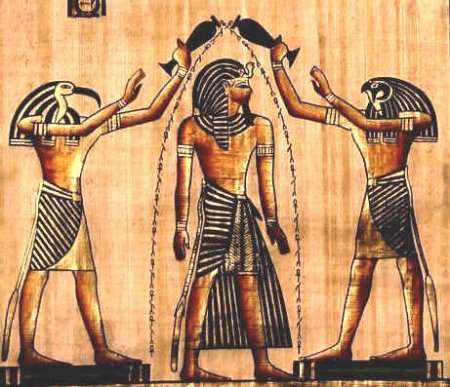
At various times, these beliefs were also inherent in the peoples of ancient Egypt. From totemism later came the so-called local deities. They existed for millennia and disappeared with the development of Egyptian religion - a system of beliefs and rituals.
In the Egyptian view, the very first deities in these Egyptian lands of northeastern Africa looked like birds and beasts. They believed in them, because then the main occupation was hunting. When the importance of hunting decreased and they became intensively engaged in farming and fishing in the Nile, the heads of some representatives of the fauna that were led there were still attached to the human body of the gods.
"Quid prodest" - who benefits?
Deities bred for a reason. Who needed the ancient Egyptian pyramids, for the construction of which for many years artisans and farmers, as well as slaves, were detached from affairs and families? Pharaohs! As evidence of the power of royal power, that is, the structure that dominates class society. The people dragged out a miserable existence and worshiped unknown idols.

And this power was required to be constantly supported not only by brute force, but also "spiritually." People are constantly urged that the power created by the gods forever. And they need to obey both the pharaohs and the common people. This involved the priests loafers. Therefore, the Egyptians silently waited for improvements from the gods - from Pharaoh to Pharaoh. From the kingdom to the kingdom.
Ancient Pantheon of Northeast Africa

Consider what were the gods of ancient Egypt, their pictures and names, which are the main ones, and who is simpler. Their pantheon is very extensive. There were about one hundred and twenty deities. Of these, local (separate cities, relatively small areas), according to various estimates, - twenty-five. Some of the local gods in different periods of the development of the ancient Egyptian kingdom passed into the rank of national, for example, Goddess Amaunet, Amenthet, Maat, God Bech (Buhis). There were even so-called minor gods. For example, Duamutef is an astral deity.
In the list there is such a category of gods and goddesses, when there is no their image or at least a brief description. For example, god or goddess Anedzhti, Bata, Bennu, Mafdet, Nebej and others. They are waiting for their researchers.
There have been other transitions of gods from discharge to discharge. Belief in the famous god Amon originated in the Old Kingdom, when the ancient Egyptian state centralized. In the Middle Kingdom, he turns into a local deity, in the New becomes the state god (18th century BC). At the beginning of our era, he was demoted into "positions" by the gods, who by then had become Egyptian in general: "husband" and "wife" Osiris and Isis.
Using the example of the god Amon, we will show how not only the preferences for the deities changed, but also their appearance of the image on the stone and in the papyrus. They are found in the largest quantities in cave paintings, on the sarcophagi of the tombs of many pharaohs and priests. At first, Amon was depicted on them as a man with the head of a frog, in the other two kingdoms on his head the disc of the Sun was already flaunted.
How the gods "competed"
The same natural phenomena were personified by the different gods of ancient Egypt, their pictures and names were different, and what they meant. Consider the example of the gods of the sun.
The main in the incarnation of the solar gods (the mythologization of the luminaries) in ancient Egypt were called Amon, Ra and Aton. Between them, or other deities, there was, as they say, fierce competition for the minds of the Egyptians. Developed it, of course, people, not mythological creatures.
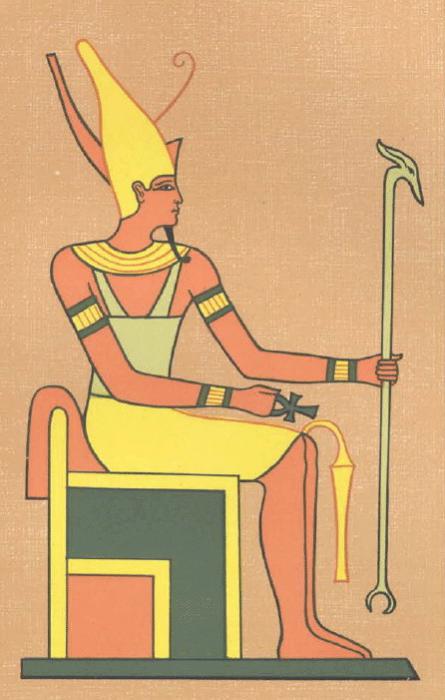
Aton was portrayed in a nontraditional, then religious way — not in the form of a man with someone’s head or animals with a man’s head. It was the only ancient artistic exception in the images of the divine pantheon. Aton is a drawing of the sun disk with rays, as modern kids like to portray it. His heyday came during the reign of Pharaoh Akhenaton. Pharaoh in ancient Egypt was considered the conductor of the idea of God on earth. Therefore, the name of God was added to the names of such kings.

Akhenaton recognized the role of only one god Aton, with him ceasing the cult of dozens of famous gods. When Akhenaten was replaced by the boy Pharaoh Tutankh, he immediately returned polytheism. In protest Ehnaton added to his name - Amon. Now the whole modern world knows this Pharaoh by the name of Tutankhamun.
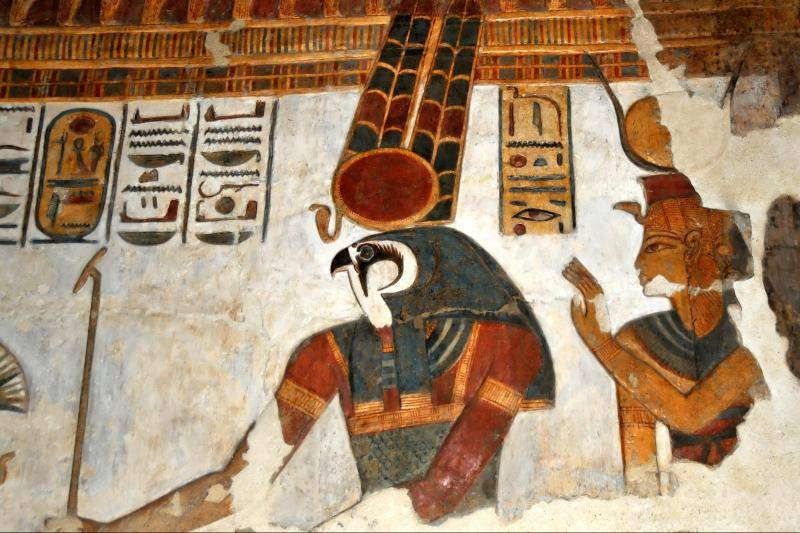
He paid for the fact that the solar disk was depicted on the falcon's head of this deity. God accompanied any ruling dynasty of Pharaoh kings in Thebes.
Expelled from the pantheon by the god Aton.
Solar deity was and Atum. He also had a difficult "relationship" with the god Ra from the solar pantheon. Atum moved from the local gods to the common Egyptian. But soon (for those times) Ra displaced him. All the solar gods of ancient Egypt have gone the same way. But it was not the gods who vied with each other, but the people in power, as was said about Akhenaten, and religious leaders (priests) helped the gods to ascend and fall.
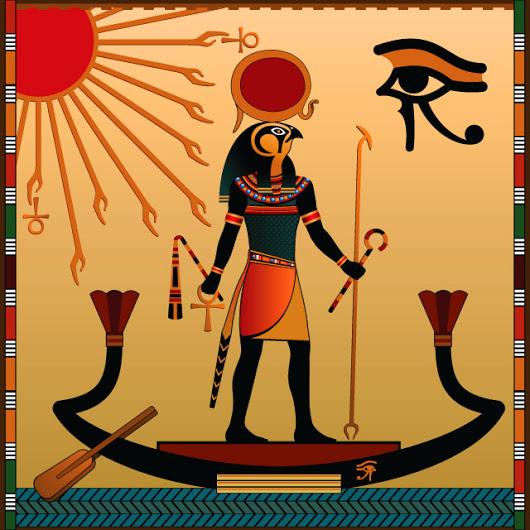
At this time, the main god of the sun was Ra, whom the ancient Egyptians endowed with the ability to create the earth, people, animals and birds, plants. Ra closes his eyes? It means darkness and night.
Special gods
Let's call the gods, which can be translated into separate groups of the pantheon. For example, the river Nile, which fit and itself is called the god of fertility and the full life of the Egyptians. The sun has become a god! Nil is the nursing home of the Egyptians. If today there was a question about the recognition of Neal as a god, then they would add a prefix to it - “honorable” and would be praised as a god.
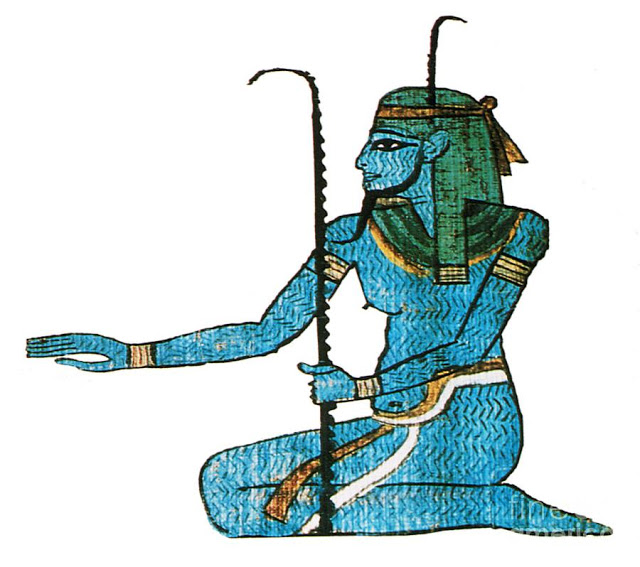
Probably, this opinion would be supported by believers of another ten countries of the African continent, through which an uncontrollable river flows from south to north.
In ancient Egypt, the Nile spills fertilized the land with fertile silt. This turned the sands in the valleys closest to the river into fertile fields. But often in July, the Nile overflowed and flooded the harvest, dooming the people to hunger. Therefore, for the river, the ancient Egyptians came up with a god - Hapyto help them. Hapi is depicted as a man with a female bust, which symbolized fertility.
It is strengthened by other gods: Sebek - the god of rivers and lakes, as well as the god of vegetation Osiris. The first portrayed in the guise of a crocodile or a man with the head of this aquatic animal.
But the cruel god demanded plentiful and regular sacrifices. God Hapi failed to tame the Nile until his disappearance from the firmament with the introduction of Christianity.

Sebek - God of the rivers and lakes.
Osiris also heads a group of the twelve gods of the so-called burial cult of the ancient Egyptians. Five of them are his associates in the afterlife. What kind of god is this? In mythology, he is killed by an envious relative. The goddess Isis, almost like an experienced surgeon, collects Osiris in parts scattered throughout Egypt and buries them. In the next world, he was resurrected and became a judge there. Other cult gods include Aker, Amenthet, Geb and others.
Pharaoh plus god
Over time, the priests formed and spread in society the postulate that the pharaohs descended from the gods. After all, the mythical deities had the same fictional families, relatives. And no wonder they did it in advance. Already in the Early Kingdom Pharaoh was perceived as the embodiment of the god Gore, and the human image and its properties were transferred to the deities. Remember the Russian folk tale about Baba Yaga. It is the same anthropomorph as the ancient Egyptian gods. Pharaohs allegedly received magical abilities, and the commoner could not be approached.
Tags: ,Ancient Egypt, in spite of everything, remains one of the most mysterious civilizations. It is still called the "gift of the Nile" and is considered the birthplace of the pyramids and the Sphinx, which fixed its eyes on the vast sands. The past and the present of this state are intertwined with the strings of historical events and amazing stories. Ancient Egyptian myths are a truly valuable gift that helps modern historians to unravel the many secrets of the past of this country. It is in them that the meaning of existence and their interaction with the outside world is laid.
Features of Egyptian mythology
Even without being a historian, any person realizes that any mythology is based on the world perception of a particular people. The ancient mythology of Egypt has amazing features that are enclosed in numerous symbols, hidden behind everyday events. To understand them through the cold mind is almost impossible. For this, it is necessary to take a philosophical look at what is hidden behind a string of words. What is the main feature of these ancient legends and legends? Ancient Egyptian mythology, first of all, urged a person not to oppose the events taking place, not to go in defiance of what is now called fate, because everything done in spite of the “wise order” will turn against humanity.
Heroes of the myths of ancient Egypt
The first myths in Egypt were written, more precisely, told, even before the construction of the famous pyramids. They contained legends about the creation of all life on earth. In addition, the ancient mythology of Egypt contained stories about the struggle of the gods for power. Unlike many Eastern peoples, the Egyptians did not like to include ordinary people in the myths, so their main characters have always been numerous gods. Some were revered and loved by the Egyptians, while others were afraid or frankly afraid. At the same time, the population of ancient Egypt was considered close to the divine beginning, because, according to the same myths, in ancient times the gods lived among people, and their direct descendants became kings and cared for their people.

Gods-villains and gods-helpers
What and about whom the mythology of ancient Egypt told? The gods are the main characters of similar works in many other civilizations. And ancient Egyptian is no exception. As mentioned above, the Egyptians divided all gods into good and evil. If the first could be “negotiated” with the help of offerings, then the second did not know mercy and could temper their anger only after huge sacrifices in the form of human lives were made. It's time to remember all the higher beings that ancient Egyptian mythology ever mentioned.
There were several supreme gods in Egypt, it depended primarily on the regions of this state. Everywhere, the Egyptians worshiped and respected the sun god Ra, and the pharaohs were considered his children. In Thebes (Upper Egypt), he was considered Amon-Ra, the god of wind and sun, while in Lower Egypt Atum, the god of the setting sun, was sovereign. In Heliopolis, located in Lower Egypt, Geb, the god of the earth, was recognized as the main deity, and in Memphis, Ptah. Here is a variety. It is worth noting that in ancient Egyptian mythology the sun god was not alone. In those days, the Egyptians praised not only the star itself, but also the stages of its existence on earth: the morning and evening sun. In addition, the god of the solar disk, Aton, was perceived as a separate divine principle.
In addition to the creatures described above, the myths about the ancient gods of Egypt mentioned other equally important and influential entities. The positive roles in this case belonged to Amat (the goddess of retribution for sins), Apis (the patron of fertility and strength), as well as the dawn or the rising sun). In addition, Anubis, Isis, Osiris and Ptah were often mentioned on the positive side of the myths. The following were considered cruel and, therefore, unloved by the highest entities in Egypt: Sebek - the god of lakes and rivers, which could only be propitiated by sacrificing him, Seth - the lord of the winds and deserts, Sekhmet - the goddess of war, cruel and merciless to all people.

Especially interesting are the ancient Egyptian myths about the creation of people, heaven and earth, that is, the world. In different centers of Egypt, the main role was assigned to a single deity, while others were either assistants to him or resisted and plotted. There was only one point of contact between these cosmogonistic directions - the Nun deity, which symbolizes the Primordial Chaos.
The myths about the creation of the world according to Heliopolis
The population of the Egyptian city of Heliopolis and its environs believed that the creation of the world, or rather, of all things on earth, was due to Atum. According to them, it was this god who was the very first creature that emerged in the depths of the Nun - a boundless, cold and dark substance. Not finding a solid place from which he could try to create light and heat, Atum created Ben-Ben, a hill towering in the middle of a cold, lifeless ocean.
After some deliberation about what else to do, God decided to create Shu (the god of wind), which could set in motion the surface of the ocean, and Tefnut (the goddess of world order), which was designed to ensure that Shu did not destroy what will be created next. Nun, seeing such a miracle, gave Shu and Tefnut one soul for two. Since there was no light in this new world, the first gods were suddenly lost. Atum sent his Eye on their search, which soon led his children to the progenitor. From the joy of Atum shed tears, they dripped onto the earth and turned into people.
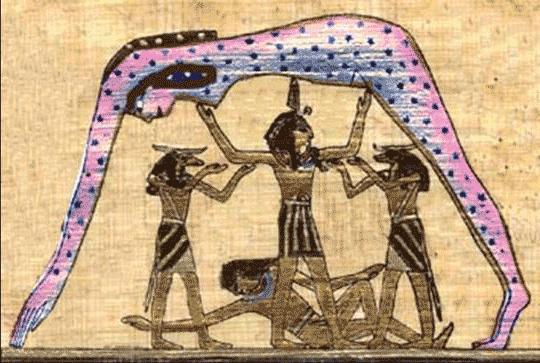
Shu and Tefnut in the meantime gave birth to Hebe and Nuth, who soon began to live as husband and wife. Soon the sky goddess Nuth gave birth to Osiris, Set and Choir, Isis and Nephthys. According to this myth, the whole divine family constitutes the Great Nine of the Gods of Egypt. But this is not the only version of the order of appearance of higher beings, and hence their primacy. The ancient mythology of Egypt contains a few more stories on this topic.
Creation: Memphis Cosmogony
According to the version of the creation of the world, set forth in the scrolls that were found in Memphis, the first god that arose in the depths of Nun was Ptah, which is the earth's firmament. By an effort of will, he pulled himself out of the ground and found a body. Ptah decided to create for himself faithful helpers from the same material from which he originated, that is, from the earth. The first was Atum, who, by the will of his father, recreated the Great Nine of the Gods of Egypt from the darkness of Nun. Ptahu could only give them wisdom and power.
Theban version of the origin of the world
In Thebes, the history of the origin of the world is somewhat different from those followed in other areas of ancient Egypt. The first and most significant difference is the number of gods: if in other versions it was the Great Nine, the Theban implies the existence of three supreme creatures: Mina - Amon - the sun god, and the war god Montu. Min was considered the creator of the whole world. Somewhat later, Ming and Amon were already represented as a single deity, symbolizing the sun, which gives light, warmth and rich harvests.
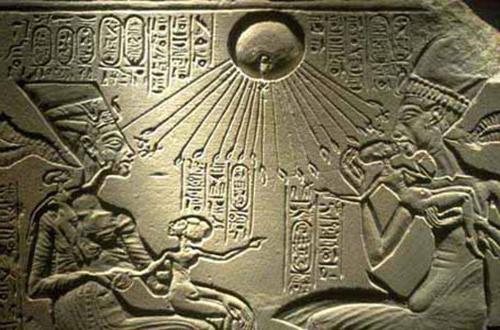
Hermopolis cosmogony about the origin of the world
The most numerous pantheon of ancient Egyptian "original" gods existed in the mythological version of the creation of the world, found in Hermopolis. In the depths of the Great Chaos (Nuna) there reigned forces aimed at destruction, consisting of three pairs of deities: Niza and Niaut, symbolizing emptiness, Tenema and Shadowuit, signifying disappearance in the darkness, and also Gereh and Gerecht - the gods of night and darkness. They were confronted by four pairs of deities endowed with positive forces: Huh and Hauhet (gods of infinity), Nun and Naunet Cook and Cauket (gods of darkness), Amon and Amaunet (invisible gods). This is the so-called Great Eight. Floating for a long time in the waters of the ocean, they created an egg and placed it on the only place above the water - the Fire Hill. After some time, young Ra, who was given the name Khepri, hatched out of him. So the gods became nine, and they were able to engage in the creation of people.

Life after death in the myths of the Egyptians
Not only the creation of the world were devoted to the myths and legends of ancient Egypt. Faith that reigned in this country assumed the existence of life after death. In Egyptian mythology, the afterworld was a large deep river, between the banks of which boats were scurrying. The souls of the dead, according to myths, after the extinction of the body turned out to be in such a boat and made a long journey between the world of the living and the dead. Only after reaching the opposite shore, the soul of the deceased could calm down. The success of this journey was provided by the gods: Anubis was responsible for the preservation of the body before the burial and after it, Selket protected the souls of the dead, Sokar protected the gates of the afterlife, Upuat accompanied the souls while traveling along the River of the Dead.

Great importance was also played by the preservation of the body of the deceased, for which he was mummified, preserving the internal organs in separate vessels. According to legends, a person could be reborn if all the rituals were performed exactly as the great wise law prescribes.
The struggle between good and evil in Egyptian myths
The ancient mythology of Egypt did not go around such a topic as the struggle between good and evil. To date, translated many stories about how the gods of Egypt fought with evil divine beings, which are most often presented in the form of crocodiles and hippos. The main fighter with them was, of course, the sun god, and the main assistants in restoring order were the original gods - Shu, Montu, Nut and others. According to mythology, Ra's battles with evil occur every day, not only in the world of the living, but also in the realm of the dead.
Features: deification of animals, developed burial cult
The cycle of myths: the creation of the world, the punishment of people for sins, the struggle of the sun god Ra with Apophis, the death and resurrection of Osiris
Ancient Egyptian religion - religious beliefs and rituals practiced in ancient Egypt, from the pre-dynastic period to the adoption of Christianity. During its many thousands of years of history, the ancient Egyptian religion has gone through various stages of development: from the Ancient, Middle and New Kingdoms to the late and Greco-Roman period.

Early beliefs
The prehistoric tribes of the Nile Valley, as well as representatives of other primitive cultures, in all the various objects and phenomena of nature, inaccessible to their understanding, saw manifestations of powerful mysterious forces. A typical form of early religion for them was fetishism and totemism, which underwent various changes, influenced by the transition of the population from nomadism to a settled way of life. The most famous ancient Egyptian fetishes: Imiut, stone Ben-Ben, pillar Yunu, pillar Jed; Also from ancient fetishes, Egyptian religious symbols originate: Ankh, Uadzhet, Uas.
Oldest fetishes:

Imiut
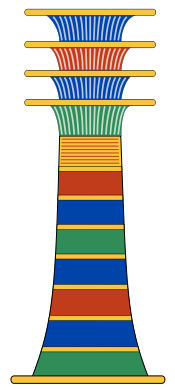
Pillar jed
To a large extent, the belief of primitive Egyptians, as well as their entire life, was influenced by the Nile, the annual spill of which inflicted fertile soil on the shores, which made it possible to harvest good harvests (the personification of beneficent forces), but sometimes it caused significant disasters - floods for a person). The frequency of the flood of the river and the observation of the starry sky, allowed with sufficient accuracy to create the ancient Egyptian calendar, thanks to this, the Egyptians learned the basics of astronomy early, which also affected their beliefs. In the first settlements of Egyptian cities that arose, there were various deities, their own for each particular locality, usually in the form of a material fetish, but much more often in the form of an animal — a totem.

Animal cult
The oldest form of religion in Egypt, as far as it can be traced through historical monuments, was the veneration of local nominal patron deities. Nomes were undoubtedly remnants of ancient tribes united at the end of the fourth millennium BC. e. under the general rule of Pharaoh. Nomes and cities were often compared and associated with their animal gods, which was reflected in their names, as well as many of the hieroglyphs of Egyptian writing were symbols of animals, birds, reptiles, fish, and insects, which were ideograms for any deities. The cult of the nominal gods proved to be extremely stable: it held to the very end of the history of ancient Egypt, already combined with the worship of Egyptian deities.
In these local cults, deeply archaic features remained, each nome honoring its sacred animal, in one way or another associated with a local god. The latter was often depicted either in the form of this animal, or in a mixed, zoo-anthropomorphic image. Examples can be given without end. Almost any representative of the Egyptian fauna was revered in a particular area (and some throughout the country). So, in the southernmost nome, Elephantine, a sheep was worshiped, in Dendera a cow, in Siouta a jackal, in Hermopolis an ibis and a baboon, in Bubastis a cat. The patroness of Nekhen, from where the oldest association of Southern Egypt proceeded, was considered the goddess-kite, and a water lily was honored nearby in Neheb. The oldest center of associations in Northern Egypt, Bugo, revered the sacred serpent, and the neighboring community of Pe - the bee. The hieroglyphs depicting the last four creatures, subsequently began to symbolize the united Egypt.
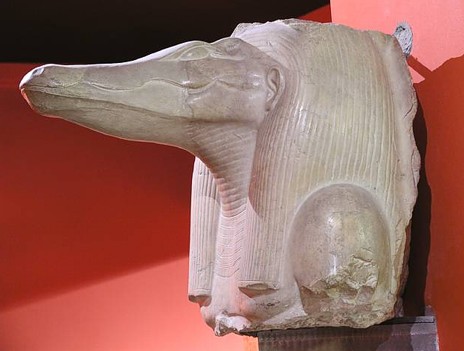
Sebek
In many localities (especially in the Fayum oasis), the crocodile was considered a sacred and inviolable ruler of river waters, and hunting for it was strictly forbidden. Small crocodiles were placed in temple ponds, fattened with honey cakes and, in case of premature death, were mummified, enveloped in burial shrouds and buried with honor.
Such birds as ibis, red-footed falcon, kite, and especially insect dung beetle (so-called scarab) enjoyed great reverence.
Sometimes one representative was selected from innumerable representatives of any kind of animals and declared to be god. The sacred bull Apis was chosen according to special features (it should have been black, but with a white round spot on the forehead, with special hairs on the tail, etc.). When such an exceptional bull was found after a long selection, it was brought to Memphis, to a special temple and declared sacred and inviolable. When his happy life ended, he was buried in a special crypt (discovered during archaeological excavations) and the city was plunged into mourning. Then the search for a new Apis began, and when it was found, mourning was followed by exultation.
Apparently, here we have the remnants of ancient totemism. Many researchers, however, are skeptical of this assumption, since the cult of animals in Egypt was local, and not generic. Meanwhile, the ethnography of Africa provides us with convincing examples of the development of the classical tribal totemism into the territorial veneration of animals: this was the case, for example, among the tribes of southern Nigeria.

Livtsa Sekhmet. The work of the modern author
Almost all researchers, on the other hand, recognize that the process of anthropomorphization of sacred animals took place in the veneration of local gods-patrons. At least, in relation to so many gods, this is beyond doubt: thus, the cat became the goddess Bastet, portrayed with a cat's head; the falcon is in the god Horus. Images of Toth with a head of an ibis, Anubis with a head of a dog, Sobek, with a head of a crocodile, the goddess Sokhmet with a head of a lioness, Hathor with a head of a cow, etc., serve as an obvious indication of the origin of these zooanthropomorphic images from sacred animals.
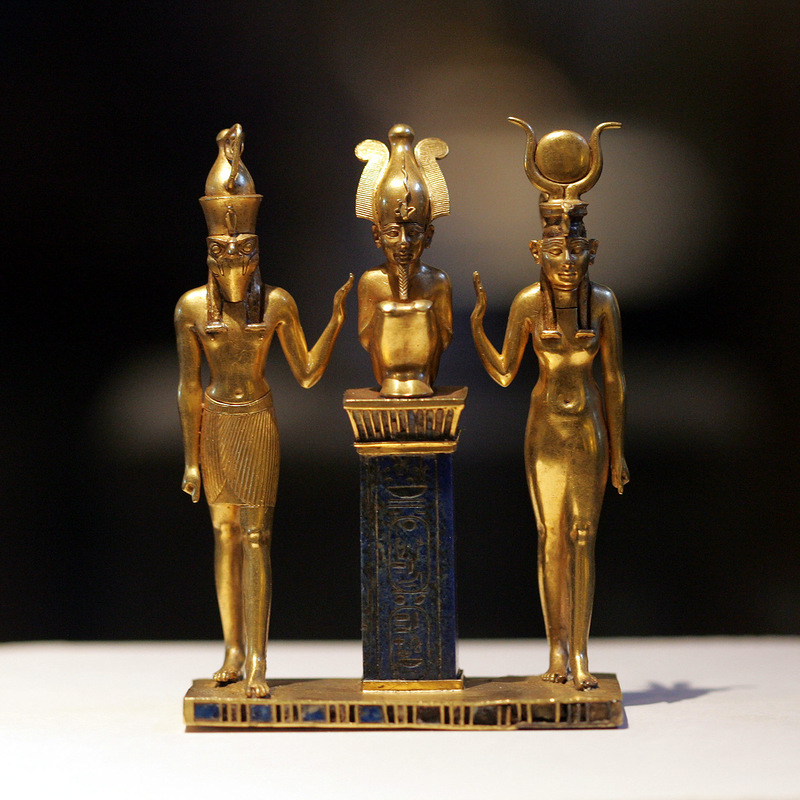
The gods Osiris, Horus and Isis. IX century BC
Pantheon of the gods of Egypt
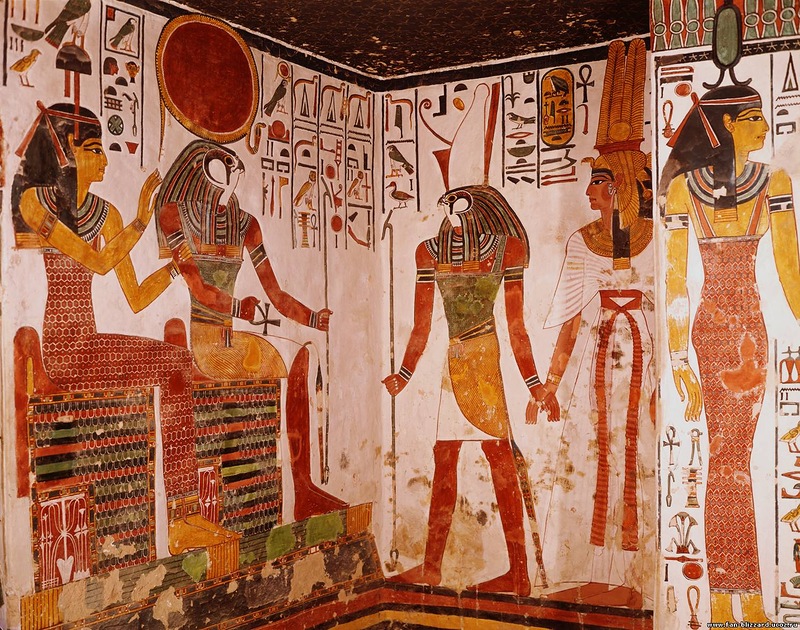
Deities of Ancient Egypt
Appearance
Egyptian gods have an unusual, sometimes quite bizarre look. This is due to the fact that the religion of Egypt was made up of many local beliefs. Over time, some gods acquired aspects, and some merged with each other, for example, Amon and Ra formed the single god Amon-Ra. In total, Egyptian mythology has about 700 gods, although most of them were worshiped only in certain localities.
A bright trace in Egyptian mythology left the cult of animals, widespread in all periods of Egyptian history. Gods in the form of animals, with the heads of birds and animals, the gods-scorpions, serpent-gods act in Egyptian myths, along with the deities in human form. The more powerful God was considered, the more cult animals were attributed to him, in the guise of which he could appear before people.
Several gods are represented by abstractions: Amon, Aton, Nun, Behdeti, Cook, Niau, Heh, Gereh, Tenem.
Some of the main deities of ancient Egypt:
Amun - the sun god
Amon (Amen, Amun, Names, "hidden", "hidden") - the ancient Egyptian sun god, king of the gods (nsw nTrw) and patron of the power of the pharaohs. Amon's sacred animal is the ram and goose (both are symbols of wisdom). God was depicted as a man (sometimes with a ram's head), with a scepter and in a crown, with two tall feathers and a sun disc. The cult of Amun originated in Thebes, and then spread throughout Egypt. The wife of Amon, the sky goddess Mut, and the son, the moon god Khonsu, together with him formed the Theban triad. Already in the First Transition Period, the first mentions of Amon appear not only as an independent deity, but as a demiurge and supreme god. The title “Wife of the god Amon” appears, which was at first possessed by high priestesses, and later exclusively by women of royal blood.

God the creator Amon. Temple of Amun-Ra at Karnak
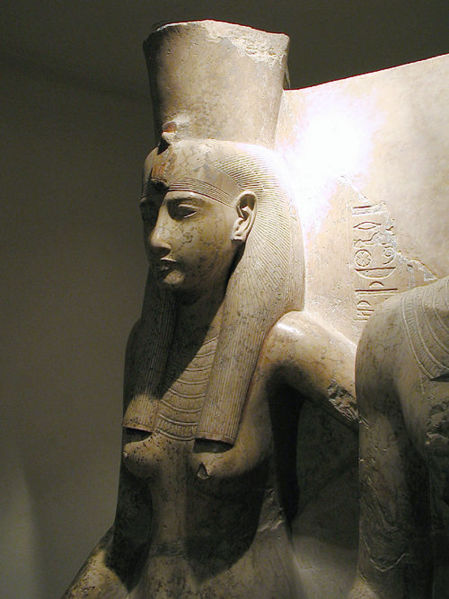
Goddess Mut. Ancient sculpture
Mut , the Egyptian goddess (actually "mother") - the ancient Egyptian goddess, the queen of heaven, the second member of the Theban triad (Amon-Mut-Khonsu), the mother goddess and the patroness of motherhood. Initially, Mut was considered the epithet of the waters of Naunet, a female pair of the original Ocean Nun, in the system of mythological views associated with the Ogdoad of Germtland. Over time, Mut herself began to act in the form of the goddess-creator. During the period of the rise of Thebes, which became the capital of Egypt in the Middle Kingdom, the value of the local god Amon, who was proclaimed king of the gods, increased accordingly, so his wife Amaunet (Amonet), who was only the female equivalent of Amon, took the more colorful goddess Mut. Mut was considered the mother, spouse and daughter of Amon, "the mother of her creator and the daughter of her son" - an expression of divine eternity. Her names also include “mother goddess”, “queen of goddesses”, “mistress (queen) of heaven”, “mother of gods”. The permanent epithet of Mut is “the mistress of Lake Ishru,” named after the sacred lake at its temple, built by Amenhotep III to the northeast of the main Karnak temple of Amon-Ra and connected with it by the alley of sphinxes. Mut was depicted as a woman, with crowns and a fingerboard - her hieroglyph - on her head. Having his own son Khonsu, Mut adopted Montu, including him in the Theban pantheon, which confirmed her status as the goddess of motherhood.
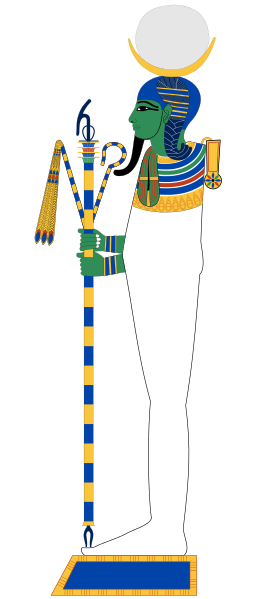
Khonsu - the god of the moon
Khonsu - ("passing"), in Egyptian mythology, the god of the moon, the god of time and his measurements, the son of Amun and the goddess of the sky, Mut. Khonsu was also worshiped as a travel god. As the patron of medicine, Khonsu became close to the god of wisdom Tot, was a member of the Theban triad of deities. During the Middle Kingdom, when he was sometimes called the scribe of truth (later, the complex deity Khonsu-Toth is often encountered). Khonsu was also considered a god of healing; We have heard a tale about the miracle of his statue, allegedly perpetrated in Mesopotamia over the king's possessed daughter (the so-called Bentresht inscription). In Thebes there was a large temple of Khonsu between the temple of Amon and Mut; he was highly honored and decorated by the Ramesessides, as well as the kings of the XXI and XXVI dynasties; from this time on the walls are preserved hymns in honor of Khonsu. He was depicted as a man with a moon crescent and a disk on his head, as well as with the head of a red-footed falcon and with the same moon attributes. On the images of Khonsu that have come down to us, we most often see a young man with a sickle and a moon disk on his head, sometimes he appears as a baby god with a finger at his mouth and a “curl of youth” that the boys wore on the side of their heads until adulthood. The center of the cult of Khonsu - Thebes, in Karnak was his main temple.

Khonsu. New Kingdom Period

Ra - Sun
Ra (ancient-Greek. Ρα; lat. Ra) - the ancient Egyptian sun god, the supreme deity of the ancient Egyptians. His name means "Sun" (Coptic PH). The center of the cult was Heliopolis, where Ra was identified with the more ancient local solar deity, Atum, and where the Phoenix bird, the bull Mnevis and the obelisk Ben-Ben were dedicated to him as his incarnations. In other religious centers of Ra in the course of religious syncretism was also compared with local deities of light: Amon (in Thebes), under the name of Amun-Ra, Khnum (in Elephantine) - in the form of Khnum-Ra, Horus - in the form of Ra-Horakhti. The latter comparison was especially common. Ra was depicted in the form of a falcon, a huge cat or a man with a falcon head surmounted by a sun disk. Ra, the sun god, was the father of Wadjit, the cobra of the North, protecting Pharaoh from the scorching rays of the sun. According to the myth, during the day the beneficent Ra, illuminating the earth, sails along the heavenly Nile in the barge Mandget, in the evening he changes to the barque Mesektet and continues his way along the underground Nile, and in the morning, having defeated the serpent Apopa in the nightly battle, reappears on the horizon. A number of myths about Ra are associated with Egyptian ideas about the changing seasons. The spring bloom of nature heralded the return of the goddess of moisture, Tefnut, with the fiery Eye shining on Ra's forehead, and her marriage to Shu. The summer heat was due to Ra’s anger against people. According to the myth, when the god Ra grew old, and people stopped honoring him and even "plotted evil deeds against him," Ra immediately gathered a council of gods headed by Nun (or Atum), in which it was decided to punish the human race. The goddess Sekhmet (Hathor), in the form of a lioness, killed and devoured people until her cunning managed to give red as blood to barley beer. Intoxicated, the goddess fell asleep and forgot about revenge, and Ra, proclaiming her vicegerent on earth, Hebe, climbed onto the back of a heavenly cow and from there continued to rule the world.
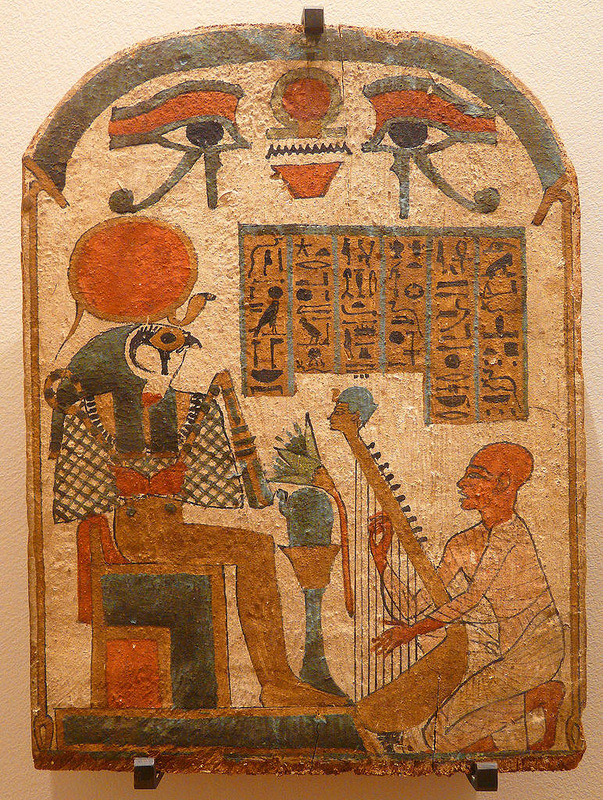
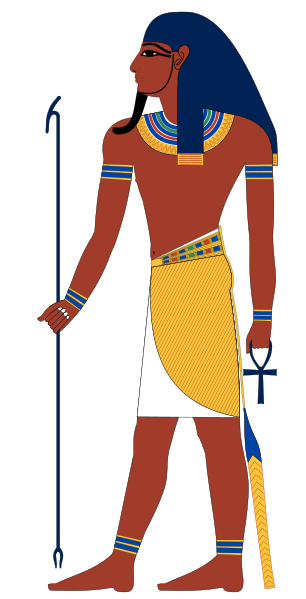
God atum
Atum (Jtm) - the god of the first creation and the sun, the demiurge, who heads the Heliopolis Ennead, is one of the most ancient gods. In many ancient Egyptian texts, Atum is called the evening or setting sun. It was depicted as a man (often an old man) in the clothes of the pharaoh with a double red and white crown of Upper and Lower Egypt. At the end of each cycle of creation, Atum took the form of a snake, as well as a lizard, a lion, a bull, a monkey, or an ichneumon (Egyptian mongoose). His title in ancient times was "Lord of both lands", that is, Upper and Lower Egypt. The hand of Atum is the goddess Yusat. According to the Heliopolis myth, Atum, "who created himself," arose from the primitive chaos - Nun, who is sometimes called the father of Atum, along with the pristine hill. He fertilized himself, that is, by swallowing his own seed, Atum begat, spitting out of the mouth, the twin gods: air - Shu and moisture - Tefnut, from which the earth - Hebe and sky - Nut. In Memphis, Atum was descended from Ptah, Atum was identified with Ptah, and also with Khepri (Atum-Khepri, in some sayings of the Pyramid Texts, this deity is called the creator of Osiris), Apis (Atum-Apis), Osiris (Living Apis-Osiris - Lord of the sky Atum with two horns on his head "). In the myth of the extermination of people, Atum heads the council of gods, in which the lioness goddess Hathor Sekhmet was charged with punishing people who plotted evil against Ra. In another myth, an angry Atum threatens to destroy everything he created and turn the world into a water element. Separately, the hand of Atum was revered as the goddess Iusat, sometimes this deity is described as the shadow of Atum. Subsequently, the worship of Atum was pushed aside by the cult of Ra, identified with him as Pa-Atum.
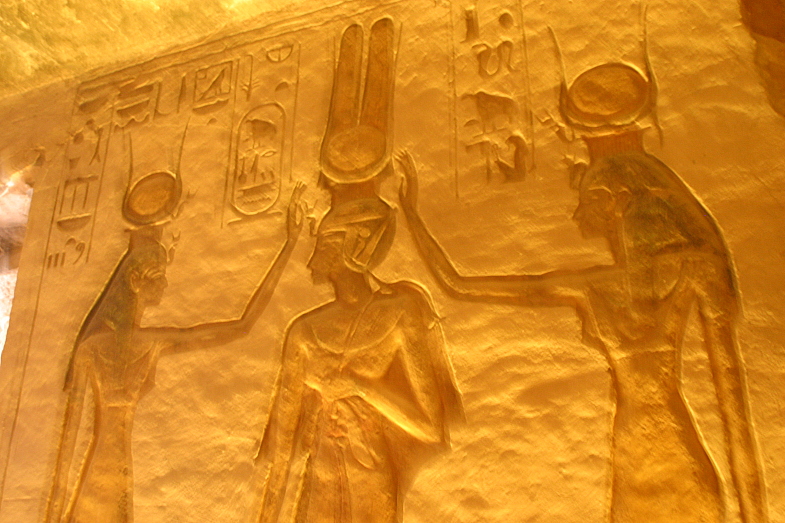
Double crown atum

God Ptah
Ptah or Ptah, is one of the names of God the Creator in the ancient Egyptian religious tradition. A creator god, patron of arts and crafts, especially revered in Memphis. Ptah created the first eight gods (his episodes - Ptah), the world and everything in it that exists (animals, plants, people, cities, temples, crafts, arts, etc.) with "tongue and heart". Conceived the creation in his heart, he expressed his thoughts and commands with words. Sometimes Ptah was called the father of even such gods as Ra and Osiris. The wife of Ptah was the goddess of war Sekhmet, the son Nefertum, the god of vegetation. Ptah was depicted as a mummy with an open head, with a rod or staff, standing on a hieroglyph meaning truth. As a living embodiment of the god Ptah, the sacred bull Apis was venerated. In Greek mythology, Hephaestus is most appropriate. The name Ptah was often accompanied by the epithet “He Who Behind the Southern Wall” (south in Egyptian symbolism is an image of eternity), in other words Ptah is God on the other side of creation, He Who is in eternity, God Himself in Himself, the Creator outside His creations. The 647 speech of the Sarcophagus Texts contains a speech on behalf of Ptah: “I am He Who is south of My wall, Lord of the gods, king of heaven, creator of souls, ruler of both lands (heaven and earth - approx.), Creator of souls who gives souls crowns, materiality and being, I am the creator of souls and their life in My hand, when I desire, I create and they live, for I am the creative word that is on My mouth and the wisdom that is in My body, My dignity is in my hands, I - Lord. The center of worship for Ptah was the city of Memphis. In a peculiar way of the mysterious and incomprehensible existence of Ptah, the very location of the Memphis Ptah temple was located outside the walls of the city, behind the southern wall. The cult of Ptah had a general Egyptian character, was also spread in Nubia, Palestine, in Sinai. According to the “Monument of Memphis Theology” - the theological work of the Memphis priests, which apparently fixes an older tradition, Ptah is a demiurge, God the Creator, who created the first eight gods (primary qualities of creation, or manifestations of His divine essence), which consisted of four pairs: Nun and Nunet (abyss), the very use of a pair of names, male and female, is a symbolic indication of the ability to give birth to life; Huh and Huket (innumerable, embracing everything, infinity), Cook and Kuket (darkness, also having the potencies of creation); Amon and Amonet (the invisibility, the absence of a certain image - not to be confused with the name of the Creator Amon) from which He creates the world and everything in it (animals, plants, people, cities, temples, crafts, arts, etc.) e.) “tongue and heart”, having conceived the creation in his heart and calling the conceived language (having uttered the Word). From Ptah came the Light and the Truth, also He is the creator of the kingdom (royalty, as the principle of the organization of life).
God Ptah. Statue from the treasury of Tutankhamen. XIV century BC

God Shu in a complex four-feather crown
Shu - The Egyptian deity of air, wind and lower sky (above which is Nut). Shu ("empty"), in Egyptian mythology, the god of air, dividing heaven and earth, the son of the solar god Ra-Atum, husband and brother of the goddess of moisture, Tefnut. He was most often depicted as a man standing on one knee with his arms raised, with which he supported the sky above the ground. According to the Heliopolis legend about the creation of the world, he was considered the father of Hebe and Nut. When the universe Shu lifted the sky - Nut - from the ground - Hebe and then supported him with outstretched hands. When Ra, after his reign, sat on the back of a heavenly cow, Shu also supported her with his hands. Thus, Shu is the god of the airspace illuminated by the sun; he subsequently gained the character of the deity of the scorching midday sun. In the hymns (in the Harris papyrus magical), Shu is renowned as a defender of the enemies of light, striking them with a spear and flame.

Shu with feather maat
God Shu - in the afterlife one of the judges of the dead. Later myths told of the reign of Shu on the earth, along with Tefnut after the departure of Ra: "His Majesty Shu was an excellent king of heaven, earth, underworld, water, wind, flood, mountains, sea." After many millennia, he also ascended into heaven. In the myth of the return from Nubia, Tefnut, the solar Oka, Shu, along with Toth, taking the form of a baboon, singing and dancing, returned the goddess to Egypt, where after her marriage to Shu, the spring blossoming of nature began.

God Shu. Ivory. XIV century BC
As the god of wind, Shu entered the Heliopolis Ennead of the gods. Shu was considered the second member of the great Ennead and compared with the god of war, Anhur (the name of the latter means "carrier of the sky"), revered in Tinis and Sebennite, with Thoth and Khonsu. Heliopolis (in Greek - "city of the sun"; the Egyptian name - Yunu), an ancient city in the Nile Delta, north of modern Cairo. From the 5th dynasty (XXVI-XXV century BC) to the Ptolemaic dynasty, Heliopolis was the center of the cult of the god Ra, who identified himself with the local god Atum, the father of the god Shu. Heliopolis itself in the Hellenistic time is identified with the biblical city He.

Tefnut - Nubian Cat
Tefnut , also Tefnetlaudable name Nubian cat - in Egyptian mythology, the goddess of moisture , moist air, dew, rain, fertility, calendar seasons, Ennead. Her earthly incarnation was a lioness (sometimes portrayed as a cat). Included in the Heliopolis Ennead. Center of worship Tefnut - Heliopolis. According to the Heliopolis myth, Tefnut and her husband, Shu, are the first pair of twin gods, spawned by Atum (Ra-Atum). Their children are Geb and Nut. Sometimes Tefnut is called the wife of Ptah. Tefnut is also Ra's daughter, his beloved eye. People said about her: “The daughter of Ra is on his forehead.” When Ra raises the horizon in the morning. Tefnut with a fiery eye shines in his forehead and burns the enemies of the great god. In this capacity, Tefnut was identified with the goddess Uto (Urey). . As a hypostasis, Tefnut was the Upes flame-goddess, the other goddess of letters Seshat often spoke of her as a hypostasis. The myth is well known, according to which Tefnut-Eye of Ra retired to Nubia (and a period of drought came to Egypt), and then at the request of his father, who sent Thoth and Shu after her (in the ancient version, Onuris). returned back. The arrival of Tefnut from Nubia and the subsequent, followed by her marriage to Shu, foreshadows the flowering of nature. Tefnut was identified with Mut, Bast, and also with Hathor, Sekhmet, and other lioness goddesses (Menhith. Menthus), worshiped in Egypt.

Geb and Nuth. (Here the goddess of the cosmos is depicted as a woman, she is curved in the shape of a dome, has exorbitantly long arms and legs (supports) and only with the tips of her fingers and legs touches the ground (depicted as a man). Shu separating this pair also does not look strained under weight "Celestial body.")
Geb - the ancient Egyptian god of the earth, the son of Shu and Tefnut, brother and husband of Nut and the father of Osiris, Isis, Set and Nephthys. Geb, in Egyptian mythology, the god of the earth, the son of the god of air, Shu, and the goddess of moisture, Tefnut. Geb quarreled with his sister and wife Nuth ("heaven"), because she ate her children every day - the heavenly bodies, and then gave birth to them again. Shu separated the spouses. He left Hebe downstairs, and Nuth raised up. Hebe's children were Osiris, Seth, Isis, Nephthys. The soul (Ba) Hebe incarnated in the fertility god Khnume. The ancients believed that Geb is kind: he protects the living and dead from the snakes living in the earth, plants grow on him, which is why people sometimes depicted him with a green face. Geb was associated with the underworld of the dead, and his title of "prince of princes" gave him the right to be considered the ruler of Egypt. Geb belonged to the Helneopolis Ennead of the gods. In the “Pyramid Texts” Geb acts as the embodiment of the underworld and the god Duat, who participates in the court of Osiris over the dead. Duat, in Egyptian mythology, the seat of the dead; According to the most ancient concepts of the Early Kingdom, it was located in the sky, in the east, where the sun rises. In the era of the Middle Kingdom in ancient Egypt, the idea of the Duat was formed as the underworld beyond the western horizon where the sun sets. The heir of Hebe - Osiris, the throne passed from him to Horus, and the Pharaohs were considered the successors and ministers of Horus, who considered their power as given by the gods.

The classic image of the goddess Nut
Chickpea (Well, Nuit) - the ancient Egyptian goddess of Heaven, daughter of Shu and Tefnut, sister and wife of Hebe and mother of Osiris, Isis, Seth and Nephthys. Under various pronunciations (Nuit, Nu, Nut), the most ancient goddess of the ancient Egyptian pantheon is known - the goddess of the sky, especially revered in the territory of Heliopolis. Behind the symbolism of Nut there is an explanation for the regular change of night and day. So, the Egyptians believed that Nuth eats the sun and the stars in order to give birth to them again. In addition, the cult of the goddess was closely associated with the afterlife, namely, it was believed that its function included the ascension of the souls of the dead to heaven, therefore, it was said that it contained “a thousand souls”. Nuth also guarded the tombs of the departed. Her epithets: "Great", "a huge mother of stars", "giving birth to gods." The classic image of Nuth is a woman stretching along the sky, touching the ground with the tips of her toes and hands. Often parallel to her on the ground is her husband and brother Geb. The widely known ancient Egyptian image of the Heavenly Cow is also associated with Nuth. But it is worth noting that there is no airspace behind it, the patron saint of which was Shu, but more distant areas, what we call Cosmos today. By the way, many researchers share the version that it is from the image of the Heavenly Cow that our Galaxy, the Milky Way, got its name.

Chickpeas in the form of Heavenly Cow
In general, it should be noted that the image of the Heavenly Cow is one of the most archaic in ancient Egyptian mythology. After decoding the texts that adorn the inner space of the pyramids, the role of this symbol became clear. In particular, they contain such phrases: “He [Pharaoh] is the son of a great wild cow. She becomes pregnant with him and gives birth to him, and places him under her wing ”; "The star swims in the ocean under the body of Nuth." From this it is obvious that Nut is an entity located even somewhere outside the stars, and the presence of wings is an additional symbol of the sky.
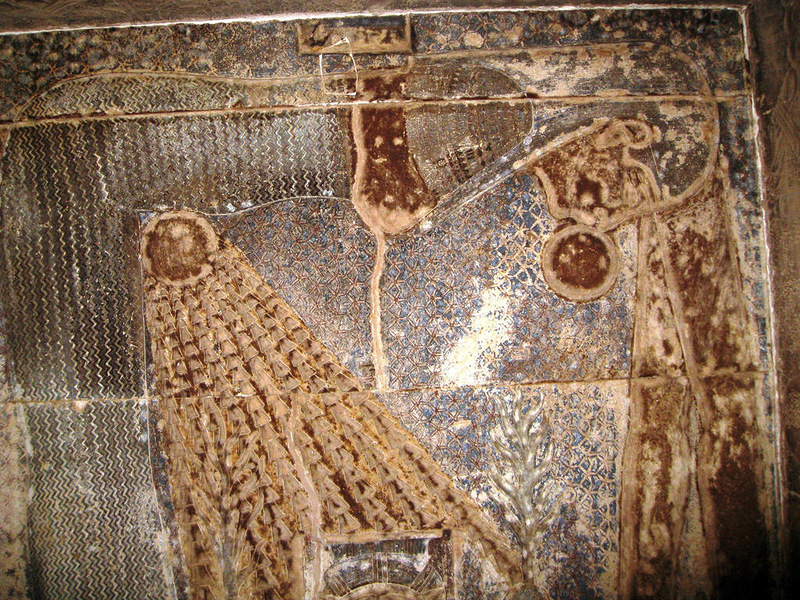
Ancient image of the goddess Nuth
The question of the essence of the cosmos was probably very interesting for the ancient Egyptians, which is why they paid so much attention to the image of the cow and woman Nut, often accompanied by images of wings, roof, ocean. Cosmos is one of the main mysteries for the ancient man, who, despite the difficulties, in every way tried the goddess Nut in the form of a heavenly cow to explain this phenomenon. The main feature of the ancient cosmos is its spiritualization, its worship as a kind of living substance. Behind abstract symbols there is a huge and mindless soul. What can not be said, by the way, about the modern understanding of the cosmos, where everything becomes extremely simple and prosaic. In ancient Egypt, there was an interesting legend associated with Nut. It was believed that Nun advised the goddess, who appeared in the image of the Heavenly Cow, to help old Ra climb the sky. However, having already reached a great height, Nuth felt that her strength was drying up, her head was spinning, and her legs were ducking. Then the old Ra ordered to call upon some gods to help the Heavenly cow to support her. The will of the sun god was performed by the great Nun. By his order, the feet of Nuth began to support eight gods, and Shu was entrusted to the belly. This story often appears as an image. In particular, in such drawings, Ra does not sit on Nut, but swims under her body in her magnificent boat, right under the stars. The sun's head crowns the head of the supreme god, although all the deities in such images have quite human features. The image of the goddess Nuth in the form of the Heavenly cow is accompanied, as a rule, with hieroglyphs “heh”, the meaning of which is interpreted as “millions of deities” or “many deities. The deities here are probably stars. It is worth noting that with this image of Nuth, cosmological symbolism often manifests itself. In particular, the gods who support the feet of the Heavenly cow do not experience gravity and easily cope with the mission entrusted to them. A powerful Shu is enough just to easily touch the body of the goddess Nuth with his fingers to hold it. According to Egyptian mythology, twin gods Isis and Osiris loved each other in the womb of the mother, the goddess Nut, therefore Isis was already pregnant at birth (Herman Melville. Collected works in three volumes. Volume 1, p. 613).
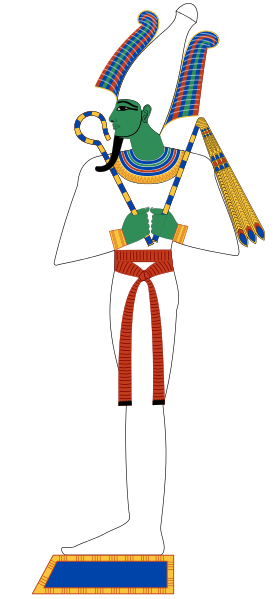
Osiris - Lord of the Underworld
Osiris (Osiris(Egyptian. wsjr, ancient Greek? σιρις, Latin Osiris) - the god of rebirth, king of the afterlife in ancient Egyptian mythology. Osiris is the god of the productive forces of nature, the lord of the afterlife, a judge in the realm of the dead. According to the references in the ancient Egyptian texts and the story of Plutarch, Osiris was the eldest son of the god of earth Hebe and the goddess of heaven Nuth, brother and husband of Isis, brother of Nephthys, Seth, father of Horus and Anubis. The tomb of Osiris was in Abydos. He reigned on the earth after the gods Pa, Shu and Hebe, he was the fourth of the gods who reigned on earth in the original times, inheriting the power of Ra's great-grandfather, Shu's grandfather and Hebe's father. Osiris taught the Egyptians agriculture, viticulture and winemaking, mining and processing of copper and gold ore, medical art, the construction of cities, established the cult of the gods.

God Osiris. Painting, VIII century BC


Isis - the great Mother Goddess
Isis (Isis) (Egypt. Js.t, ancient Greek? Σις, lat. Isis) - one of the greatest goddesses of antiquity, which became a model for understanding the Egyptian ideal of femininity and motherhood. The name of Isis means "the one of the throne." She was revered as the sister and spouse of Osiris, the mother of Horus, and, respectively, of the Egyptian pharaohs, who were originally considered the earthly incarnations of the Sacological God. The symbol of Isis was the royal throne, the token of which is often placed on the head of the goddess. From the epoch of the New Kingdom, the cult of the goddess became closely intertwined with the cult of Hathor, with the result that Isis sometimes has a dress in the form of a sun disk, framed by the horns of a cow. The holy white cow of Heliopolis, the mother of the Memphis bull Apis, was considered the sacred animal of Isis as the mother goddess. She was identified with Demeter, the Great Mother Rhea-Kibela, with Ishtar and Anat. According to ancient tradition, she invented sails when she was looking for her son Harpocrates (Horus). One of the most widely used symbols of the goddess is the amulet of tet - “the knot of Isis,” or “the blood of Isis,” often made of red minerals — cornelian and jasper. Like Hathor, Isis commands gold, which was considered a model of impatience; on the sign of this metal she is often depicted kneeling. The heavenly manifestations of Isis are, first and foremost, the star Sopdet, or Sirius, “the mistress of the stars,” with the rising of which the Nil spills from one goddess’s tears; as well as the formidable hippopotamus Ishida Hesamut (Isis, a formidable mother) in the guise of the Great Bear constellation, which keeps the leg of a dissected Seth in the sky with the help of its crocodile satellites. Also Isis, along with Nephthys, can appear as gazelles storing the horizon of the skies; the emblem in the form of two gazelles-goddesses was worn on tiaras by the younger spouses of Pharaoh in the epoch of the New Kingdom. Another incarnation of Isis is the goddess Shentait, who appears in the form of a cow, the patroness of funeral blankets and weaving, the mistress of the sacred sarcophagus, in which the body of the murdered brother Osiris is reborn, according to the axial ritual of the mysteries. The side of the world, which the goddess commands - the west, her ritual objects - the sistre and the sacred vessel for milk - sieve. Together with Nephthys, Neith and Selket, Isis was the great patroness of the deceased, protected the western part of the sarcophagi with her divine wings, commanded the anthropomorphic spirit of Imseti, one of the four "sons of Horus", the patrons of the canopies. Being very ancient, the cult of Isis probably originates from the Nile Delta. Here was one of the oldest religious centers of the goddess, Hebet, named by the Greeks Isayon (present. Behbayt al-Hagar), which is currently in ruins.
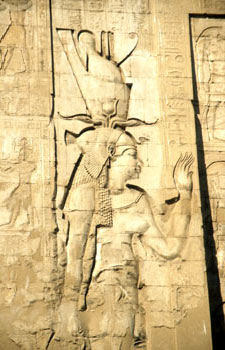
Goddess Isis. 1300 BC
The famous sanctuary of Isis, which existed until the disappearance of the ancient Egyptian civilization, is located on the island of Philae, near Aswan. Here, the goddess, revered in many other temples of Nubia, was worshiped until the VI century AD. e., at a time when the rest of Egypt was already Christianized. Other centers of worship of the goddess were located throughout Egypt; The most famous of them are Koptos, where Isis was considered the wife of the god Min, the lord of the eastern desert; Dendera, where the sky goddess Nuth gave birth to Isis, and, of course, Abydos, in the holy triad of which the goddess entered with Osiris and Horus.
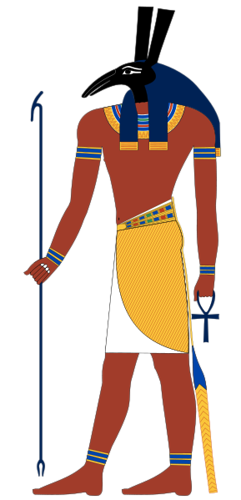
Seth - the god of sandstorms, alien lands and the patron of foreigners,
originally the protector of the sun god Ra
Set (Seth , Suteh , Suta , Network Egyptian Stẖ) - in ancient Egyptian mythology, the god of rage, sandstorms, destruction, chaos, war and death. The god of the deserts, that is, "foreign countries," the personification of the evil inclination, brother and murderer of Osiris, one of the four children of the god of the earth Hebe and Nut, the goddess of the sky. Honored with pre-dynastic times. Initially: the protector of the sun-Ra from Apophis, lord of military valor and courage. After the era of Narmer and especially the Ptolemies, he was demonized: the patron of countries far from Nile and foreigners, world evil, the desert, was drawn closer to Apop, the antagonist in Seth and Osiris-Choir dualism. Seth also embodied the evil inclination - as the deity of a merciless desert, the god of strangers: he chopped down sacred trees, ate the sacred cat of the goddess Bast, etc. Similar metamorphoses were reflected in the meaning of the name Set. The patron of royal power, his name in the titles of pharaohs of the II dynasty (the combination of the names of Set and Horus means "king") and in the names of the pharaohs of the XIX dynasty. Later, the hieroglyph "Seth's beast" was a determinative of the words "wild, evil, ferocious." The set is depicted, as a rule, with long ears, a red mane and red eyes (the color of death, that is, desert sand, although its image can be found quite differently). There are images in the form of various animals, but there is no exact evidence that this is Seth. The myth of Seth is known, spitting into the eyes of Choir, assuming the appearance of a black pig. Because of this, pigs were considered unclean (despite the fact that in ancient times there were images of chickpeas in the form of pigs with star pigs). The cult of Set flourished in Ombos (near Nakad), Kom-Ombos, Gipsel, the Dakhla and Kharga oases, and especially in the northeastern Delta of the Nile. The oracle of Set existed in the Dakhla oasis right up to the XXII dynasty. Although already in the time of the 26th dynasty, this god became an obvious personification of evil. In Greek mythology, Seth was identified with Typhon, a dragon-headed serpent, and considered Gaia and Tartarus to be the son.

Nephthys (Greek Νέφθυς, in Egyptian Nbt-hat = "mistress of the house"), Nebethet (dr.-egyp. "The mistress of the monastery") - in Egyptian mythology, the youngest of the children of Hebe and Nut. The goddess of the Ennead, death, afterlife, healing, creation, sexuality, arousal, defender of the dead, patroness of the archive of the reigning house of the pharaohs. Symbolizes inferiority, passivity, barren land. Depicted in the image of a woman with the hieroglyph of her name on her head (a house with a construction basket upstairs). Was considered and honored Seth's wife, but, judging by the texts, very little connected with it. Its essence is almost not disclosed in Egyptian religious literature. In the mythological texts, however, Nephthys appears together with her sister Isis in the mysteries of Osiris and in all the requiem magical rites. She, together with Isis, mourns Osiris, participates in the search for his body, guards his mummy, standing at the head of his bed. Both sisters at the eastern sky meet the deceased. Neftida was the companion of Ra during his night voyage through the underground waters. Nephthys, whose Egyptian name is pronounced Nebethet, was regarded by some authors as the goddess of death, and by others as an aspect of Black Isis. Neftis was also sometimes called the Lady of the Scrolls and attributed to her the authorship of mournful hymns and other hymns. In this guise, she was closely associated with Seshat, the goddess, the patroness of the archive of the reigning house of the pharaohs, defining the duration of their rule. The special time of day for Nephthys was pre-dawn and sunset twilight. It was believed that she was born in Sekhem, which was the center of her cult. Plutarch described Nephthys as "the mistress of all that is not revealed and immaterial, while Isis rules over everything manifested and material." Despite the connection with the Lower World, Nephthys wore the title "Goddess of creation, who lives in everything." She was also considered the goddess of sexuality and the female equivalent of the ever-excited god Ming. In Mendes, in the Nile delta region, she was honored as the goddess of healing. Often Nephthys was portrayed with Isis as her opposite, and at the same time as her complement, symbolizing inferiority, passivity, barren land. According to the papyrus tales, Westkar Nephthys together with Isis, Khnum and Heket help the woman in labor. Sometimes, together with Isis, she is represented as one of the falcon faces sitting at the feet and head of the bed with the body of the deceased. In the era of the New Kingdom, Nephthys, as one of the four great goddesses defenders of the deceased, was often depicted on the royal sarcophagi, on the northern wall, directly near the head of the deceased. According to the Pyramid Texts, Nephthys floats in the night barge (Isis - in the daytime). Neftida, Isis and Selket were identified with falcones, so they are often depicted on sarcophagi as winged women as defenders of the dead. Sheshat often performed the role of Nephthys.
About Egyptian mythology
Sources of study of the mythology of ancient Egypt are incomplete and unsystematic presentation. The nature and origin of many myths are reconstructed on the basis of later texts. The main monuments, reflecting the mythological representations of the Egyptians, are a variety of religious texts: hymns and prayers to the gods, records of funeral rites on the walls of tombs. The most significant of them, the Pyramid Texts, are the oldest texts of the requiem royal rituals carved on the walls of the interior of the pyramids of Pharaohs V and VI of the dynasties of the Old Kingdom (XXVI - XXIII centuries BC); “Sarcophagus texts”, preserved on the sarcophagi of the Middle Kingdom (XXI - XVIII century BC), “Book of the Dead” - composed from the period of the New Kingdom to the end of the history of Egypt.
Egyptian mythology It began to form in the 6th - 4th millenniums BC, long before the emergence of a class society. Each region (nome) has its own pantheon and cult of gods, embodied in heavenly bodies, stones, trees, birds, snakes, etc.
The value of the Egyptian myths is invaluable, they provide valuable material for a comparative study of religious ideas in the Ancient East, and for the study of the ideology of the Greco-Roman world, and for the history of the emergence and development of Christianity.
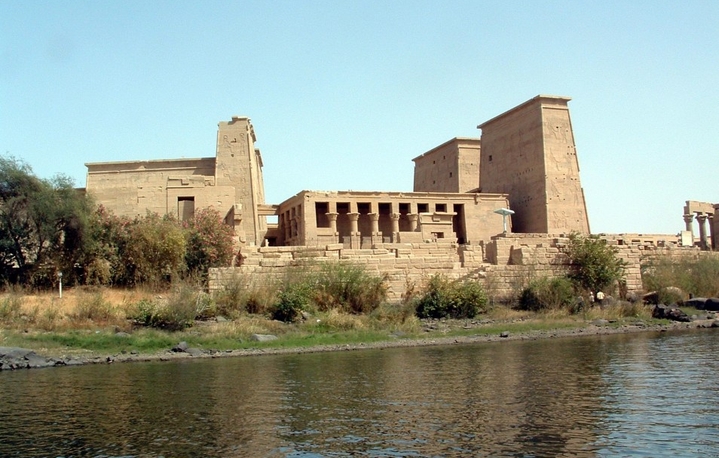
Ancient temple on the banks of the Nile
Cosmogonic Myths
Judging by the data of archeology, in the most ancient period of Egyptian history there were no cosmic gods to whom creation of the world was attributed. Scientists believe that the first version of this myth arose shortly before the unification of Egypt. According to this version, the sun was born from the union of earth and sky. This personification is undoubtedly older than the cosmogonic ideas of the priests from the major religious centers. As usual, the already existing myth was not rejected, and the images of Hebe (the god of the earth) and Nut (the goddess of the sky) as the parents of the god of the sun Ra remain in religion throughout ancient history. Every morning, Nuth produces the sun and hides it every night in the womb.
Theological systems that offered a different version of the creation of the world, probably arose at the same time in several major religious centers: Heliopolis, Hermopolis and Memphis. Each of these centers declared the creator of the world its main god, who was, in turn, the father of other gods, united around him.
Common to all cosmogonic concepts was the idea that the creation of the world was preceded by a chaos of water immersed in eternal darkness. The beginning of the exit from chaos was associated with the emergence of light, the embodiment of which was the sun. The idea of water space, from which a small hill initially appears, is closely related to Egyptian realities: it almost exactly corresponds to the annual spill of the Nile, the muddy waters of which covered the entire valley, and then, retreating, gradually opened up the land, ready for plowing. In this sense, the act of creating the world was repeated every year.
Egyptian myths about the beginning of the world do not constitute a single, coherent story. Often the same mythological events are depicted in different ways, and the gods in them appear in different shapes. It is curious that with a multitude of cosmogonic plots explaining the creation of the world, very little space is given to the creation of man. The ancient Egyptians thought that the gods created the world for people. In the written literary heritage of Egypt there are very few direct indications of the creation of the human race, such indications are an exception. Basically, the Egyptians confined themselves to the conviction that a person owes his existence to the gods who expect gratitude from him, understood very simply: a person must worship the gods, build and maintain temples, and make sacrifices regularly.
The priests of Heliopolis created their version of the origin of the world, declaring it the creator of the sun god Ra, identified with other gods - the creators of Atum and Khepri (Atum means “Perfect", the name Khepri can be translated as "He who arises" or "He who leads to the emergence of "). Atuma was usually depicted as a human, Khepri as a scarab, which means that his cult dates back to the time when the gods were given the appearance of animals. It is curious that Khepri never had his own place of worship. As the personification of the rising sun, he was identical with Atum - the setting sun and Ra - the luminous day. The appearance of a scarab attached to it was associated with the belief that this beetle is able to multiply by itself, hence its divine creative power. And the sight of a scarab pushing its ball suggested to the Egyptians the image of a god rolling the sun across the sky.
The myth of the creation of the world by Atum, Ra, and Khepri is recorded in the Pyramid Texts, and by the time its text was first carved in stone, it probably existed long ago and was widely known.

The statue of Ramses II in the temple of Ptah in Memphis
According to the Pyramid Texts, Ra-Atum-Khepri created himself, having arisen from chaos, called Nun. Nun, or Pervookean, was usually depicted as an immense pre-bright water space. Atum, having emerged from it, did not find a place where it could be kept. Therefore, he first created the hill Ben-ben. Standing on this island of solid soil, Ra-Atum-Khepri set about creating other cosmic gods. Since he was alone, he had to give birth to the first couple of gods himself. From the union of this first pair, other gods arose, thus, according to the Heliopolis myth, the earth and the ruling deities appeared. In the continuing act of creation from the first pair of gods - Shu (Air) and Tefnut (Moisture) - Geb (Earth) and Nut (Sky) were born. They in turn gave birth to two gods and two goddesses: Osiris, Seth, Isis and Neftida. Thus arose the Great Nine of the Gods - the Heliopolis Ennead. This version of the creation of the world was not the only one in Egyptian mythology. According to one of the legends, the creator of people was, for example, a potter - the god Khnum, who appeared in the guise of a ram, - who molded them from clay.

Isis with wings
The theologians of Memphis, the largest political and religious center of ancient Egypt, one of its capitals, incorporated into their myth of the creation of the world many gods belonging to different religious centers, and subordinated them to Pt as the creator of everything. Compared to Heliopolis, the Memphis version of cosmogony is much more abstract: the world and the gods were created not by a physical act — as in the process of creation by Atum — but solely by thought and word.
Sometimes the vault of heaven was represented as a cow with a body covered with stars, but there were still representations according to which the sky is the water surface, the heavenly Nile, along which the day flows around the earth during the daytime sun. Under the ground, too, there is the Nile, on it the sun, descending beyond the horizon, floats at night. The Nile, flowing through the land, was personified in the image of the god Hapi, who contributed to the harvest with his blessed spills. Sam Neil is also inhabited by good and evil deities in images of animals: crocodiles, hippos, frogs, scorpions, snakes, etc. fertility field was in charge of the goddess - the mistress of granaries and barns renenutet, revered as a snake, which appears on the field during the harvest.. watching the thoroughness of the harvest. The grape harvest depended on the god of the vine, Xai.

Anubis as a dog. Figurine from the tomb of Tutankhamen

Anubis with mummy. Painting on the wall of the tomb of Sennedzhem
The myths of the requiem worship
An important role in Egyptian mythology was played by ideas about the afterlife as a direct continuation of the earth, but only in the grave. Its necessary conditions are the preservation of the body of the deceased (hence the custom of mummifying corpses), the provision of housing for him (the tomb), food (the requiem gifts brought by the living and the victims). Later, ideas arise that the dead (that is, their ba, soul) go out into the sunlight during the day, soar to the gods in the sky, wander through the underworld (duat). The essence of man was conceived in the indissoluble unity of his body, souls (they were believed to have several: ka, ba; the Russian word “soul”, however, is not an exact match of the Egyptian concept), name, shadow. Various monsters await the soul wandering through the underworld kingdom, from which you can escape with the help of special spells and prayers. Over the deceased Osiris, along with other gods, administers the afterlife trial (the 125th chapter of the Book of the Dead is specially dedicated to him). In the face of Osiris, psycho-stasis takes place: the deceased's heart is weighed on scales balanced by truth (with the image of the goddess Maat or her symbols). The sinner was devoured by the terrible monster Amt (the lion with the head of a crocodile), the righteous came to life for a happy life on the fields of Jaru. Justified at the court of Osiris could only be submissive and patient in mortal life, one that did not steal, did not encroach upon temple property, did not rebel, spoke no evil against the king, etc., as well as “pure in heart” (“I am pure , clean, clean "- says the deceased at the trial).

Goddess Isis with wings
Agricultural Myths
The third main cycle of the myths of ancient Egypt is associated with Osiris. The cult of Osiris is associated with the spread of agriculture in Egypt. He is the god of the productive forces of nature (in the "Book of the Dead," he is called grain, in "The Pyramid Texts" —the god of the vine), of fading and resurrecting vegetation. So, sowing was considered the burial of grain - Osiris, the emergence of seedlings was perceived as its rebirth, and cutting off the ears of corn during the harvest - as killing God. These functions of Osiris are reflected in an extremely common legend describing his death and rebirth. Osiris, who reigned happily in Egypt, was treacherously murdered by his younger brother, the evil Seth. The sisters of Osiris Isis (at the same time being his wife) and Nephthys have been looking for the body of the murdered man for a long time, and having found, they mourn. Isis conceives from the dead husband the son of Horus. Having matured, Gore enters into the struggle with Seth, at the trial of the gods, with the help of Isis, he is seeking recognition of himself as the sole legitimate heir to Osiris. After defeating Seth, Horus resurrects his father. However, Osiris, not wanting to remain on earth, becomes the king of the afterlife and the supreme judge of the dead. The throne of Osiris on earth passes over to Horus. In another version of the myth, the resurrection of Osiris is associated with the annual floods of the Nile, which are explained by the fact that Isis, who mourns for Osiris, after the “night of tears” fills the river with her tears.

God Osiris. The painting of the tomb of Sennedzhem, XIII century BC
The myths associated with Osiris are reflected in numerous rites. At the end of the last winter month "khoyak" - the beginning of the first month of spring "tibi" the mysteries of Osiris were committed, during which the main episodes of the myth about it were reproduced in dramatic form. Priestess in the image of Isis and Nephthys portrayed the search, mourning and burial of God. Then came the "great battle" between Gore and Seth. The drama ended with the hoisting of the Jed pillar dedicated to Osiris, which symbolized the rebirth of God and, indirectly, the whole of nature. In the pre-dynastic period, the holiday ended with the struggle of two groups of mystery participants: one of them represented summer, and the other represented winter. Victory always won the summer (the resurrection of nature). After the unification of the country under the rule of the rulers of Upper Egypt, the nature of the mysteries changed. Now two groups are fighting, one of which is in the clothes of upper Egypt, and the other is of the Lower. The victory, of course, remains for the group that symbolizes Upper Egypt. In the days of the Mysteries of Osiris, the dramatized coronation rites of the pharaohs also coped. During the mystery, the young pharaoh played the role of Horus - the son of Isis, and the deceased king was portrayed by Osiris, seated on a throne.
The character of Osiris as a god of vegetation was reflected in another cycle of rites. In a special room of the temple, a kind of clay made of clay was made up of the figure of Osiris, which was sown with grain. By the holiday of Osiris, his image was covered with green shoots, which symbolized the rebirth of God. In the drawings, the mummy of Osiris is often found with seedlings sprouted from it, which are watered by the priest.
The idea of Osiris as a god of fertility was transferred to Pharaoh, who was considered the magic center of fertility of the country and therefore participated in all the basic ceremonies of an agricultural character: with the onset of the time of the ascent of the Nile, he threw a scroll into the river - a decree that the spill began; the first solemnly began preparing the soil for sowing; cut the first sheaf at the harvest festival, for the whole country brought a thank-offering sacrifice to the goddess of the harvest, Renenutet, and to the statues of the dead pharaohs after the completion of the field work.

Bastet cat
The Egyptian myths reflect the peculiarities of the world view of the inhabitants of the Nile Valley, their ideas about the origin of the world and its organization, which were established over thousands of years and go back to primitive times. Here and attempts to find the origins of life in the biological act of creation of the gods, the search for the original substance, personified by divine couples - the germ of the later teachings about the primary elements of the world, and, finally, as one of the highest achievements of Egyptian theological thought - the desire to explain the origins of the world, people and all culture as a result of creative power embodied in the word of god.



